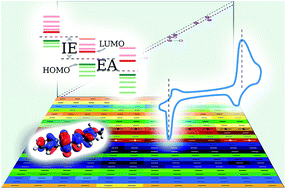Rational computing of energy levels for organic electronics: the case of 2-benzylidene-1,3-indandiones†
Abstract
Device engineering in organic electronics, an active area of research, requires knowledge of the energy levels of organic materials (traditionally but ambiguously denoted as HOMO and LUMO). These can be effectively determined by electrochemical investigation, but yet more effective would be quantum chemical (QC) computation of these quantities. However, there is no consensus on the computational method in the research community. Ongoing discussions often focus on choosing the right density functional method, but neglect other model parameters, in particular, the basis set. This study considers comparison of various methodologies and parameters for predicting ionization energy I and electron affinity A. Our aim was to outline a QC ‘recipe’ used in the search of new structures with desired energy levels for application in the field of organic electronics. Validation of calculated results to electrochemically determined values through linear regression and effect decomposition were used for compiling the recipe, ensuring trend-descriptive and resource–effective combination of QC model parameters. In particular, accounting for solvation by the medium is found to be essential and hardly consuming any additional CPU time. Basis set extension with extra valence functions is found to be much more effective than by adding diffuse functions. Among explored methods, B3LYP/6-311G(d) + CPCM is the recommended one for ionization energy, providing experimental quality results suitable for screening purposes. CAM-B3LYP is deemed more efficient for electron affinity, though by far not achieving the desired quality. Correction by computed reference redox pair potential is also found to be overall advantageous.



 Please wait while we load your content...
Please wait while we load your content...